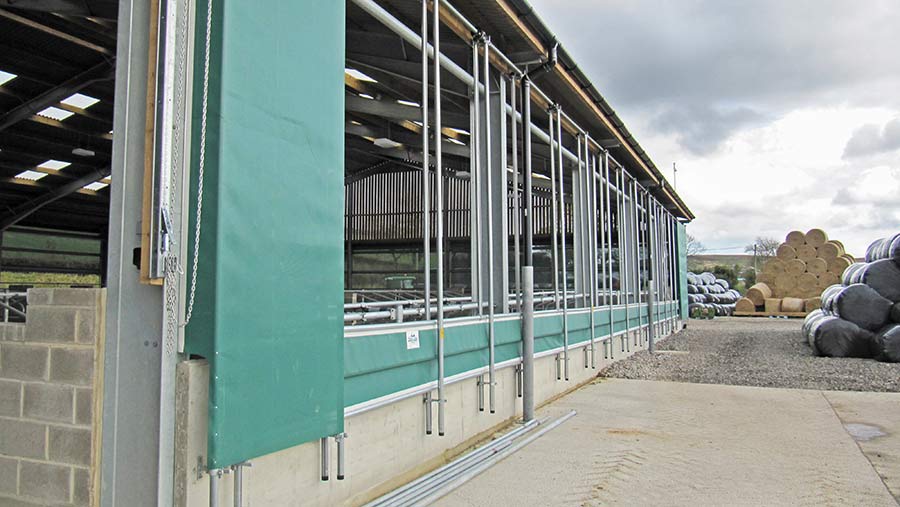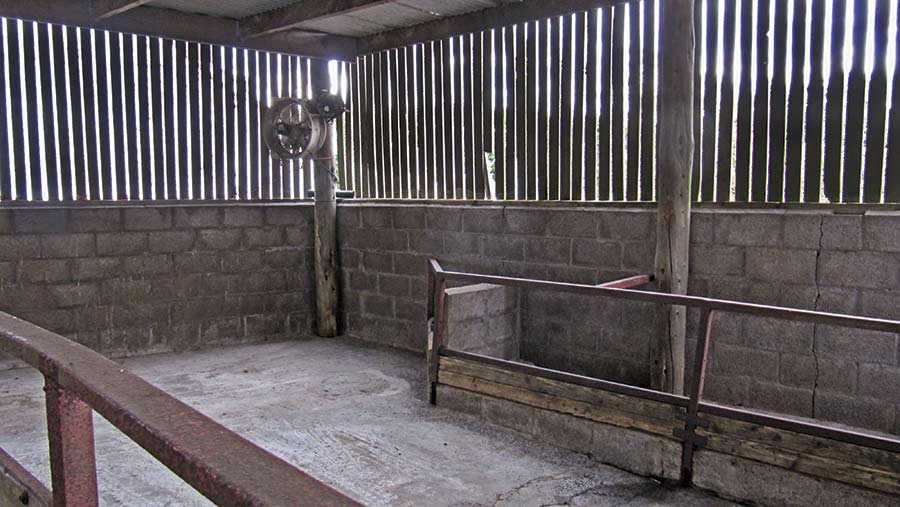Building for better herd health: shed walls
 An example of a variable sidewall
An example of a variable sidewall The basic requirements of the livestock building roof are simple. It must keep out the rain, provide shade and it must breathe.
However, the design requirements of walls are more complex. In older buildings the walls support the roof; in modern, steel-framed buildings there is no such requirement.
Jamie Robertson, research fellow at the University of Aberdeen and consultant at Livestock Management Systems, explains how to design shed side walls that are fit for purpose.
See also: Building for better herd health: Designing shed roofs
The design of walls must take into account both livestock and human requirements. They must:
- Retain stock in a safe, non-injurious manner
- Protect stock from the negative effects of the wind and keep out the rain
- Be cost-effective, durable, easy to clean and safe
- As with roofs, there is a further fundamental requirement: the walls must breathe
Making walls breathable
The role of the sidewalls in competent building ventilation is 80-90% of the whole package and is a significant component of the successful health and productivity of housed livestock.
The design of the sidewall should allow the wind to naturally ventilate buildings 80-90% of the time, providing the wind can access the building.
The irony is that wind-driven ventilation is free, but too many buildings are poorly ventilated and therefore the potential for improvement is vast.
The stack effect – the movement of air into and out of buildings driven by the body heat of animals – becomes essential inside a building when wind speed drops below 1m/s, or where a building is protected from the wind.
Wall height recommendations and calculating inlet areas
The basic requirement is for the wall to be solid to just above animal height to protect from the negative effect of wind speed. Wind can reduce growth rates and increases stress on vulnerable stock.
Above animal height the sidewall needs to be open or perforated to allow the wind to vent the building and remove heat, moisture and bugs.
The inlet area required is defined as a minimum of twice the calculated outlet area in the roof. For example, a shed housing 100 cows with a 10sq/m outlet in the ridge will need a minimum of 10sq/m in each sidewall.

A simple spaceboard. Effective, but not suitable for exposed sides or gables.
The inlet area is critical. A building that is 30m long and needs a 10sq/m inlet area in each sidewall could have an inlet consisting of either:
- 0.33m high gap for the full length of the building, below the eaves
- 1.5m-high Yorkshire boarding with a 25% void (6″ board, 2″ gap)
- 2.2m height of spaceboard with a 15% void (6” board, 1” gap)
- 6.5m-high Ventair sheeting with a 5% void
If the inlet area is too small it will always restrict the stack effect. However, doors should not be relied on for inlet areas unless there is no other source. Doors are controlled by fallible humans and they do not control air speed, they accelerate it. Also, they open onto passageways, not pens.
Is the inlet too big?
This depends on the degree of exposure of the sidewall to the climate, especially wind.
An open-sided building that is protected from direct wind, and with a decent overhang to keep rainwater off the feed, presents little or no risk to the stock.
The type of cladding should manage the expected weather pattern, for all months of the year.
Some modern sidewall designs are variable inlets, such as curtains. These can vary the amount of inlet area according to the immediate weather conditions and thereby create optimum environmental conditions for stock.
Which brings the final point, one that stands up and contributes to significant chronic health conditions and much reduced performance. The solid wall.
No wind can get through a solid wall, so free ventilation and free removal of accumulated heat, moisture and bugs is denied.
The wall’s purpose is to keep out the wind and rain, yet in so doing it keeps out the vital fresh air.
This is where the material used on top of pen sidewalls comes into play. In most parts of the UK the predominant wind direction (from the South West, for example) is effective for maybe 50% of the time each year, even more in the winter.
Where you have buildings with solid sidewalls or gable ends that are facing South West, you should try to use material that allows in fresh air, reduces the airspeed to design levels and keeps most, if not all, of the rain out.
Each and every one of those buildings would perform better with no additional running costs.
The required cladding for breathing walls where large openings are not sustainable or the building is very exposed includes either:
- Yorkshire board (not spaceboard because this allows rain and wind in)
- High-spec vented sheet
- Tight or solid sheeting, which is offset from the top of the solid pen wall to leave a large horizontal, protected gap
